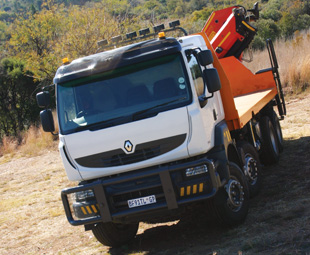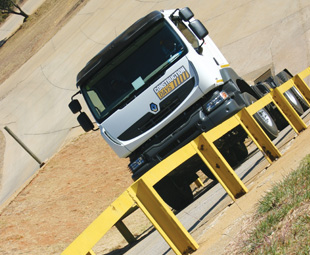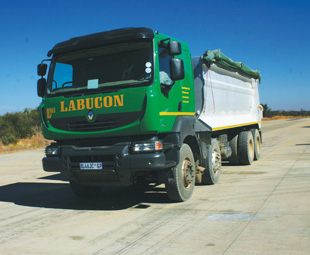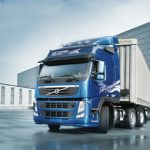The French connection

Bums in seats. That’s what you need in order to tell trucks. This is why Renault Trucks holds Construction Days for its clients. GAVIN MYERS went along to the Gerotek testing facility outside Pretoria to park his butt in the driver’s seat …
Renault Trucks has a relatively small part of the local extra heavy commercial vehicle (EHCV) sector, but those who opt for the French manufacturer’s products stick with them for a reason.
Renault Trucks, part of the Volvo Group, has a presence in over 100 countries, with over 1 600 sales and service points and 14 000 employees. In 2010, the French manufacturer sold almost 45 000 commercial vehicles, ranging from 2,7 to 120-tonnes.
“We thought the best way for us to demonstrate our trucks would be to let customers see and experience them on some very challenging tracks,” says David Rouger, managing director of Renault Trucks South Africa. “Our range consists not only of construction vehicles, but also distribution, long haul and special vehicles. The technology behind these vehicles is very well developed in Europe and is starting to come here to South Africa.”
 Being a French company, Renault Trucks has a strong presence in north- and east-African French-speaking counties, Rouger explains. It is slowly rebuilding its presence in South Africa, having just opened another service point in the country, bringing the total to 16.
Being a French company, Renault Trucks has a strong presence in north- and east-African French-speaking counties, Rouger explains. It is slowly rebuilding its presence in South Africa, having just opened another service point in the country, bringing the total to 16.
The company has identified four sectors within the construction industry: quarrying, mining, ready-mix concrete transportation and earth moving projects.
It offers two vehicle options to tackle the associated applications:
• The Kerax, designed to be the benchmark for vehicle overload capacity and sturdiness for the toughest heavy-duty assignments in mining, earth moving and quarry works; and
• Versions of its Premium Lander, which offers optimised operating costs for site-supply applications in concrete transport, mining and distribution.
These might only be two vehicles, but between them they offer operators 70 different vehicle configurations in terms of rigid and truck-tractor chassis, cab sizes, wheelbases and axle tandem capacities. Both the Premium Lander (in 4×2 and 6×4 truck-tractor and 4×2, 6×4 and 8×4 rigid format) and Kerax (in 4×2, 4×4, 6×4 and 6×6 truck-tractor and 4×2, 4×4, 6×4, 6×6 and 8×4 rigid format) have reinforced chassis with a high torsion capacity to accept overloading without permanent deformation.
On the suspension front, parabolic, mechanical and semi-eliptic mechanical suspension is offered. So too is an extensive range of axle capacities which are said to offer an excellent compromise between durability and load capacity without affecting comfort – which we would put to the test later in the day. Both vehicles offer consistent ground clearance between the front and rear. All configurations of the Kerax have a new flat axle without any offset to allow maximum ground clearance of 380 mm in the front and 370 mm at the rear.
 Renault Trucks understands that pulling power is a non-negotiable in the construction industry. The new DXi engine range offers up more power and torque, which has enabled longer axle ratios to be fitted; therefore allowing the engines to run at lower revs, cutting fuel consumption and emissions. On offer are the 238 kW (320 hp) DXi7 and 246, 283 and 328 kW (330, 380 and 440 hp) DXi11 engines. The Lander in DXi7 form (the Kerax is not available with this engine) comes standard with a ZF nine-speed manual gearbox, while the Lander and Kerax equipped with a DXi11 engine are equipped as standard with a 16-speed robotised Optidriver+ gearbox – designed to increase change speed and optimise driveability and fuel consumption.
Renault Trucks understands that pulling power is a non-negotiable in the construction industry. The new DXi engine range offers up more power and torque, which has enabled longer axle ratios to be fitted; therefore allowing the engines to run at lower revs, cutting fuel consumption and emissions. On offer are the 238 kW (320 hp) DXi7 and 246, 283 and 328 kW (330, 380 and 440 hp) DXi11 engines. The Lander in DXi7 form (the Kerax is not available with this engine) comes standard with a ZF nine-speed manual gearbox, while the Lander and Kerax equipped with a DXi11 engine are equipped as standard with a 16-speed robotised Optidriver+ gearbox – designed to increase change speed and optimise driveability and fuel consumption.
Different options are available for retardation. The Lander with a DXi7 engine and nine-speed gearbox can be equipped with a ZF intarder, and the DXi11 engines with the Optidriver+ gearbox have the option of an intarder or Voith retarder with braking power of up to 500 kW.
Atop all this is a redesigned cab – reworked to be more robust and compact, featuring a new radiator grille for better airflow and side anti-splash protectors to reduce dirt projection and improve the vehicle’s aerodynamics.
Renault Trucks had a couple of driving experiences lined up for us, most notable of which was the hill ascent and decent exercise. The company had its local and French driver trainers demonstrate the vehicles’ capabilities (both 6×4 Kerax models, one a tipper and one a chassis-cab) on some rather steep gradients. It was impressive to see how, using just the engine brake and slight footbrake to keep all the wheels turning at the same speed, the laden tipper crept its way down a 27°/50 percent gradient. Coming back up, the driver parked the vehicle halfway up and, with a simple engagement of the diff-lock, pulled off again as smoothly as if he were on flat ground.
Customers were also given the opportunity to sample a 440 hp 8×4 Kerax tipper on the facility’s ride and handling track. Renault customer Labucon supplied the vehicle for these test drives. It impressed with its seamless power delivery, relative agility and comfort.
Overall, those in attendance at the 2012 Construction Day were suitably impressed by the vehicles (though it would have been nice to see what the Premium Lander has to offer as well), while Renault Trucks was confident it had given everyone a reason to construct a few new relationships too.
Published by
Focus on Transport
focusmagsa



